This post may contain affiliate links. Please read our disclosure policy.
This single serving Mongolian Beef recipe features tender strips of flank steak cooked in a rich, slightly sweet sauce made with soy sauce, brown sugar, garlic, and ginger. Ready in just 20 minutes, it’s a flavorful, easy-to-make meal that tastes even better than takeout.
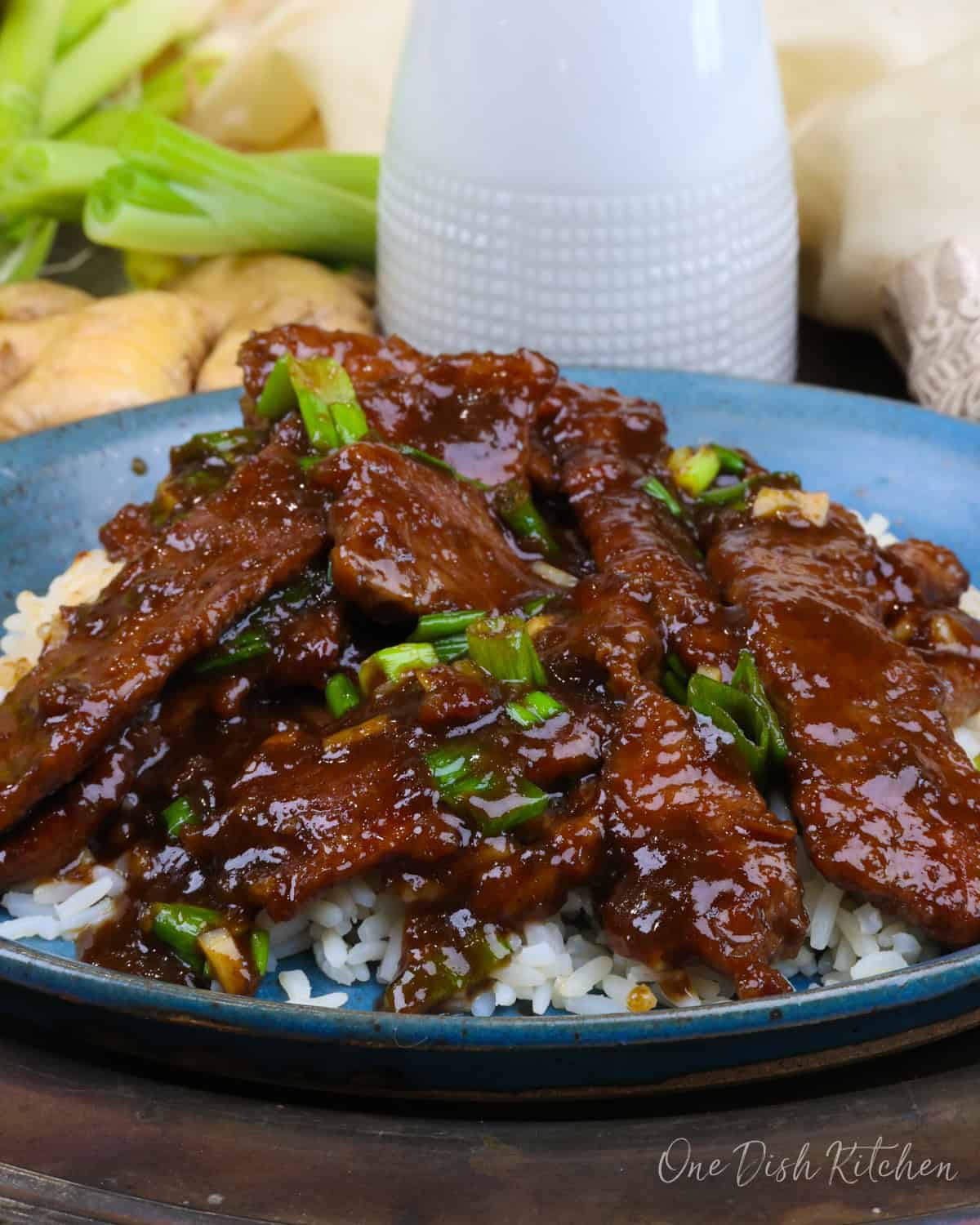
Featured Comment
“So satisfying! I made as directed and was so yummy…”
– Kris
Why You’ll Love This Recipe
- Quick & Easy: Thinly sliced beef cooks in minutes with simple pantry staples.
- Rich, Flavorful Sauce: A perfect balance of savory, sweet, and garlicky flavors.
- Customizable: Adjust the spice level, add vegetables, or serve it your way.
Mongolian Beef is one of those dishes that reminds me why I love cooking at home – simple ingredients, bold flavors, and a meal that feels like a treat.
The combination of tender beef and a rich, slightly sweet sauce is incredibly satisfying, making it a perfect choice when you want something quick but packed with flavor. I hope it brings as much comfort to your table as it does to mine!
Looking for more Asian-inspired meals for one! Try our sing serve kung pao chicken, beef and broccoli for one, single serve pepper steak, or our small batch shrimp fried rice recipe—each packed with bold, delicious flavors.

Ingredients
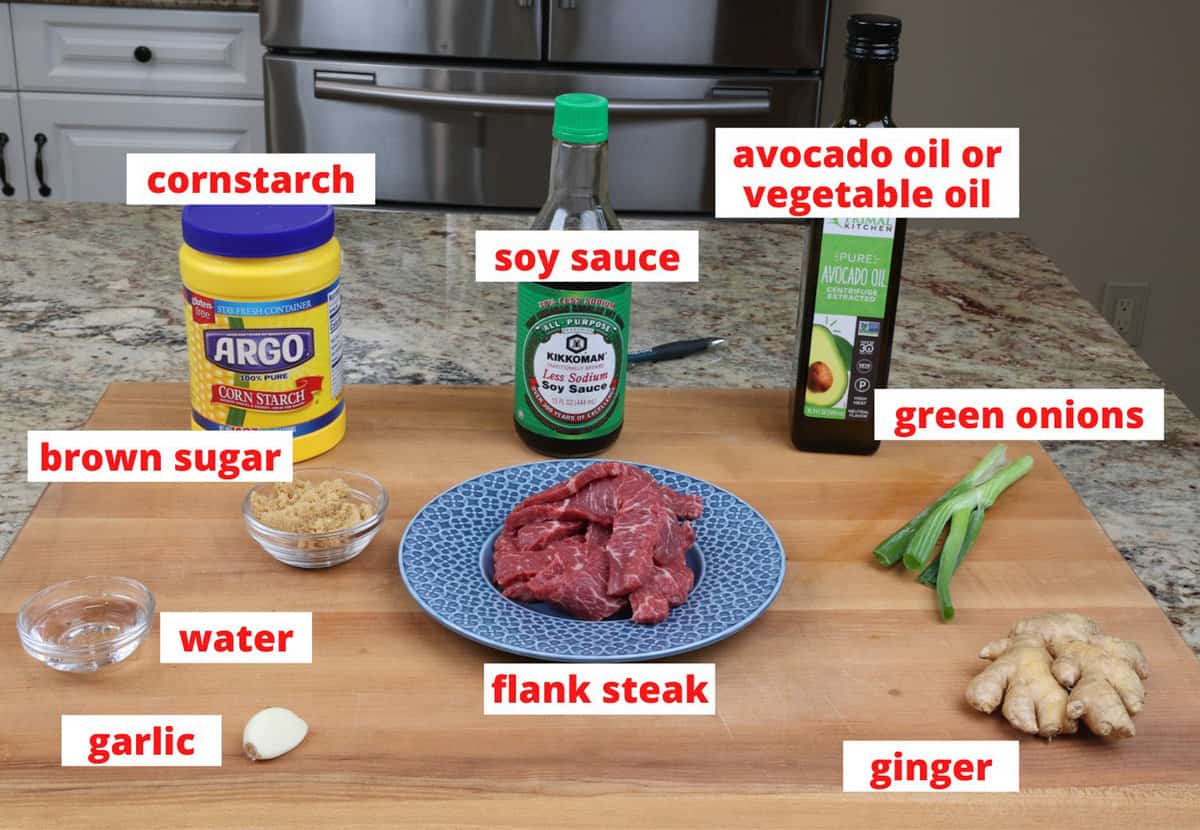
If you have any ingredients leftover from this small batch Mongolian Beef recipe, check out our Leftover Ingredients Recipe Finder.
- Flank Steak: The best cut for Mongolian beef. It’s lean, flavorful, and budget-friendly. If flank steak isn’t available, skirt steak or hanger steak work well. Flat iron or sirloin steak are also good options. Leftover flank steak? Use it in my quick and easy carne asada recipe and single serve steak fajitas.
- Pro Tip: For tender beef, slice against the grain into 1/4-inch thick strips. A sharp knife helps with precision. Freezing the steak for 20 minutes before slicing makes it easier to cut thinly without tearing.
- Cornstarch: Thickens the sauce and gives it a glossy finish. If unavailable, flour can be used, but the sauce won’t have the same clear sheen.
- Soy Sauce: Provides a rich umami flavor. I use low sodium soy sauce to better control the salt level. Regular soy sauce works but will make the dish saltier. For a gluten-free option, use tamari.
- Brown Sugar: Adds sweetness and balances the salty soy sauce. White sugar can be used but lacks the depth of flavor from molasses. You can also try homemade brown sugar, honey, or maple syrup.
- Vegetable or Avocado Oil: Ideal for stir-frying due to their high smoke points. Canola, sunflower, or grapeseed oil are good alternatives.
- Fresh Ginger: Adds warmth and depth. Leftover ginger? Use it in single serving chicken tikka masala, saag paneer for one, or a healthy green smoothie. If fresh ginger isn’t available, use 1/8 teaspoon of ground ginger per teaspoon of fresh.
- Garlic: Essential for building flavor. If fresh garlic isn’t available, substitute with jarred minced garlic or 1/8 teaspoon of garlic powder.
- Green Onions: Add color and mild onion flavor. If unavailable, chives, leeks, or shallots can work, though leeks and shallots have a stronger taste.
Recipe Variations
Mongolian Beef is easy to customize! Here are a few ways to change up the dish:
- Spicy Mongolian Beef: Add red pepper flakes, sliced jalapeños, or a dash of sriracha for extra heat.
- Vegetable-Packed: Stir in bell peppers, broccoli, snap peas, or carrots for added color and nutrition.
- Extra Crunch: Top with toasted sesame seeds or crushed peanuts for a bit of texture.
How To Make Mongolian Beef
These photos and instructions show you how to make a single serving of Mongolian Beef. See the recipe box below for ingredient amounts and full recipe instructions.
- Coat the Steak: Slice the steak into 1/4-inch strips and place in a bowl. Add cornstarch and toss until evenly coated. Alternatively, place the steak and cornstarch in a ziplock bag and shake to coat.
- Make the Sauce: In a small bowl, whisk together the soy sauce, brown sugar, and water. Set aside.
- Cook the Steak: Heat oil in a 10-inch skillet over medium-high heat. Add the steak and cook for 1-2 minutes per side until browned. Transfer to a plate and cover.
- Sauté Aromatics: Add garlic and ginger to the pan and cook, stirring constantly, for 30 seconds.
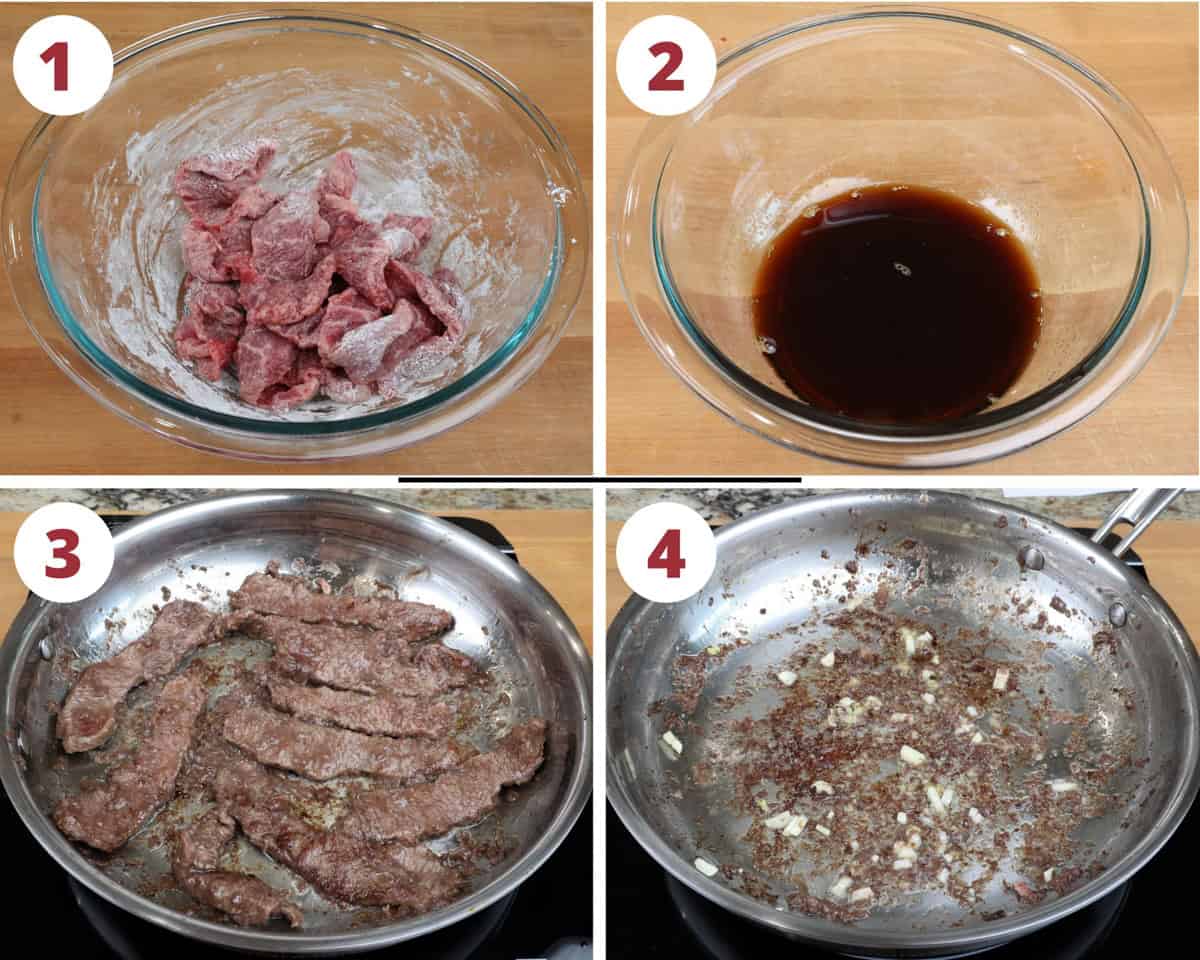
- Simmer the Sauce: Pour in the sauce and cook, stirring frequently, until it comes to a boil.
- Combine: Return the steak to the pan and stir for 2-3 minutes until the sauce thickens.
- Finish: Stir in the green onions and cook for 20 seconds
- Serve: Enjoy over rice.
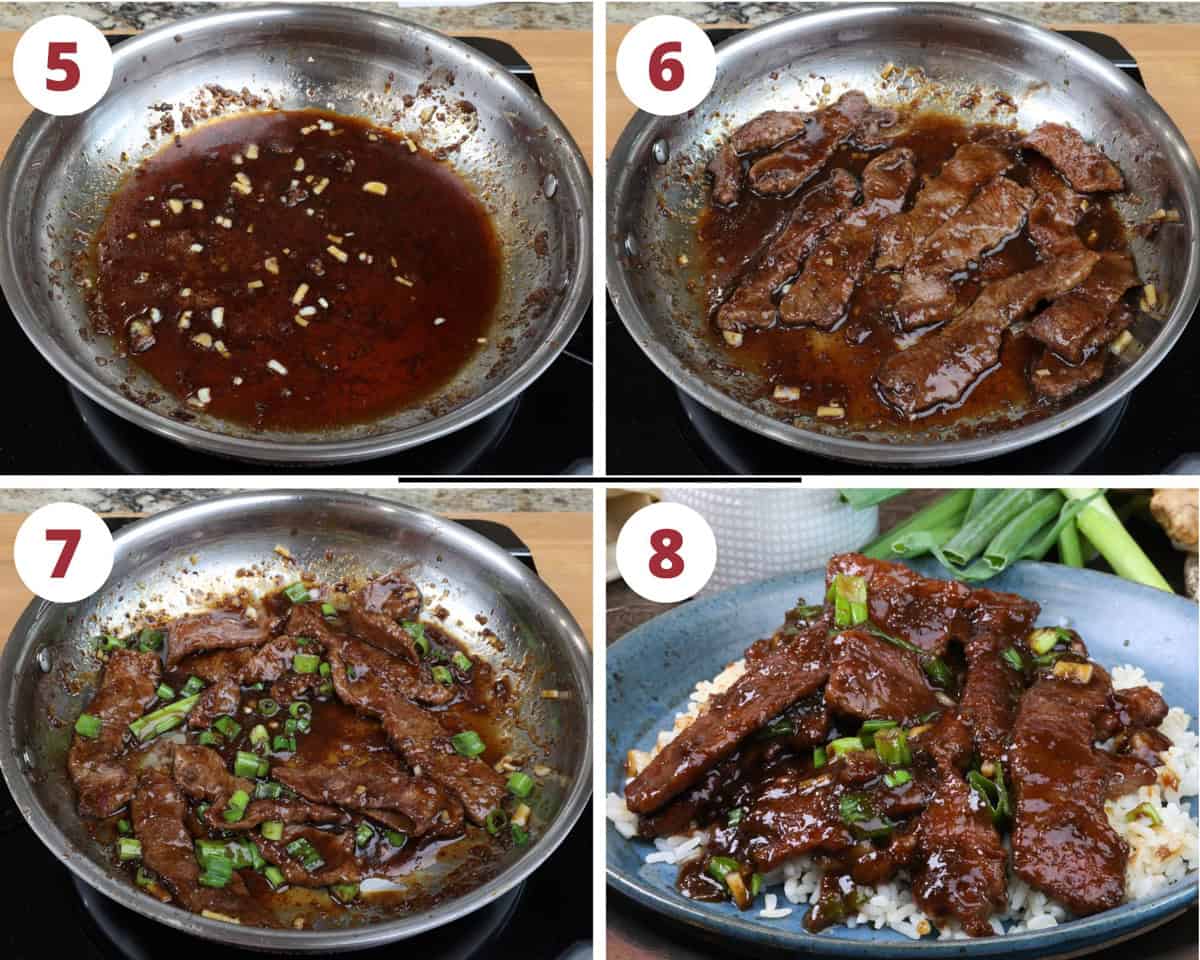
Expert Tips
- Prepare Ahead: Read through the recipe and ingredient notes before starting. This dish cooks quickly, so having everything prepped ensures the best results.
- Maintain Heat Control: Keep the pan at medium-high heat for a good sear on the beef without overcooking.
- Use Fresh Ingredients: Fresh ginger, garlic, and green onions add the best flavor—avoid dried substitutes if possible.
- Thicken the Sauce: If needed, let the sauce simmer a bit longer to reach your desired consistency.
Serving Suggestions
Mongolian Beef pairs well with a variety of sides. Here are some great ways to serve it:
- Over Rice: White rice is the classic choice, soaking up the flavorful sauce. Brown rice works well for a heartier option.
- With Noodles: Serve over rice noodles, lo mein, or even buttered pasta.
- With Vegetables: Add stir-fried or steamed broccoli, bell peppers, bok choy, or snow peas.
- In Lettuce Wraps: A great low-carb option that adds a refreshing crunch.
- As a Sandwich or Slider: Use Mongolian Beef as a filling for sandwiches or sliders.
Frequently Asked Questions
Yes, you can prep the sauce and slice the beef in advance. Cook just before serving for the best results.
Store in an airtight container in the fridge for up to 3 days. Reheat in a skillet over medium heat or in a microwave until warmed through.
Yes. To make Mongolian Beef for two, double the ingredients.
Ways To Use Leftover Ingredients
If you have any ingredients leftover from this recipe, check out our Leftover Ingredients Recipe Finder or you might like to consider using them in any of these single serving and small batch recipes:
If you’ve tried this easy Mongolian Beef or any recipe on One Dish Kitchen please let me know how you liked it by rating the recipe and telling me about it in the comment section below.
Mongolian Beef For One
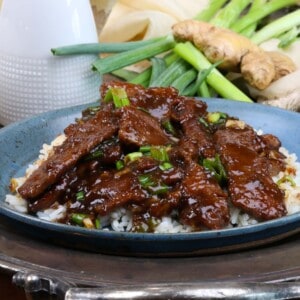
Equipment
Ingredients
- 6-8 ounces flank steak sliced against the grain in ¼ inch strips *see notes
- 1 tablespoon cornstarch
- 2 tablespoons low sodium soy sauce
- 2 tablespoons brown sugar
- 1 tablespoon water
- 1 tablespoon vegetable oil or avocado oil or canola oil
- 1 clove garlic -minced
- ¼ teaspoon finely minced ginger or ⅛ teaspoon ground ginger
- 3 tablespoons chopped green onions
Instructions
- Coat the Steak: Place the strips of steak in a bowl. Add cornstarch and toss until evenly coated. Alternatively, place the steak and cornstarch in a ziplock bag and shake to coat.
- Make the Sauce: In a small bowl, whisk together the soy sauce, brown sugar, and water. Set aside.
- Cook the Steak: Heat oil in a 10-inch skillet over medium-high heat. Add the steak and cook for 1-2 minutes per side until browned. Transfer to a plate and cover.
- Sauté Aromatics: Add garlic and ginger to the pan and cook, stirring constantly, for 30 seconds.
- Simmer the Sauce: Pour in the sauce and cook, stirring frequently, until it comes to a boil.
- Combine: Return the steak to the pan and stir for 2-3 minutes until the sauce thickens.
- Finish: Stir in the green onions and cook for 20 seconds.
- Serve: Enjoy over white rice, if desired.
Notes
-
- Prepare Ahead: Read through the recipe and ingredient notes before starting. This dish cooks quickly, so having everything prepped ensures the best results.
-
- Maintain Heat Control: Keep the pan at medium-high heat for a good sear on the beef without overcooking.
-
- Use Fresh Ingredients: Fresh ginger, garlic, and green onions add the best flavor—avoid dried substitutes if possible.
-
- Thicken the Sauce: If needed, let the sauce simmer a bit longer to reach your desired consistency.
- For tender beef, slice against the grain into 1/4-inch thick strips. A sharp knife helps with precision. Freezing the steak for 20 minutes before slicing makes it easier to cut thinly without tearing.
Nutrition
The information shown is an estimate provided by an online nutrition calculator. It should not be considered a substitute for a professional nutritionist’s advice.
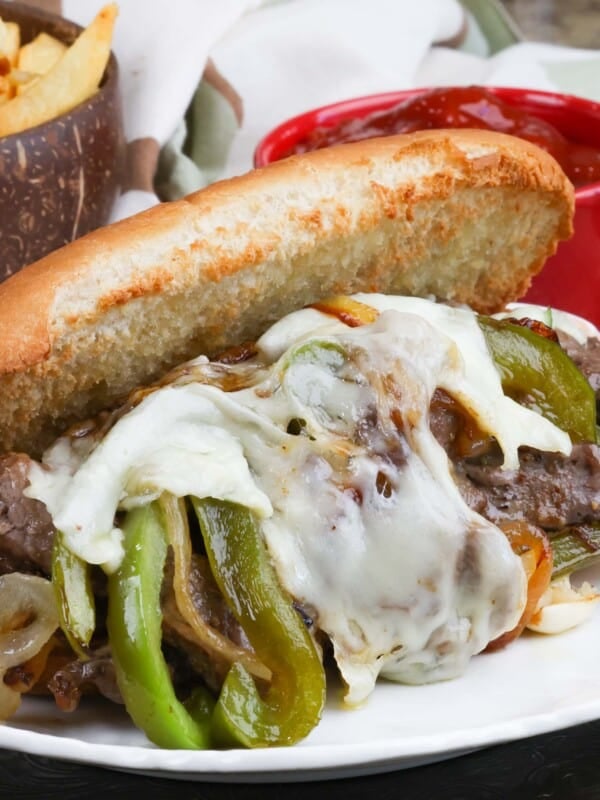
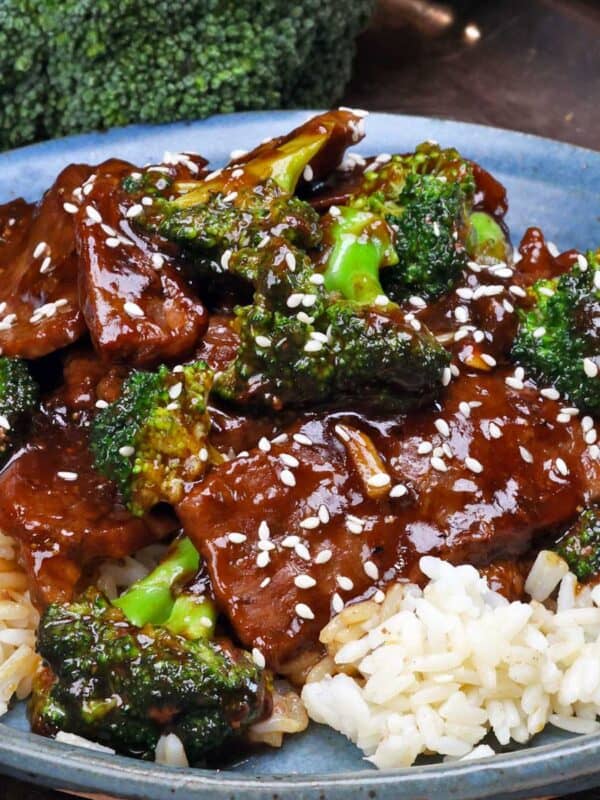

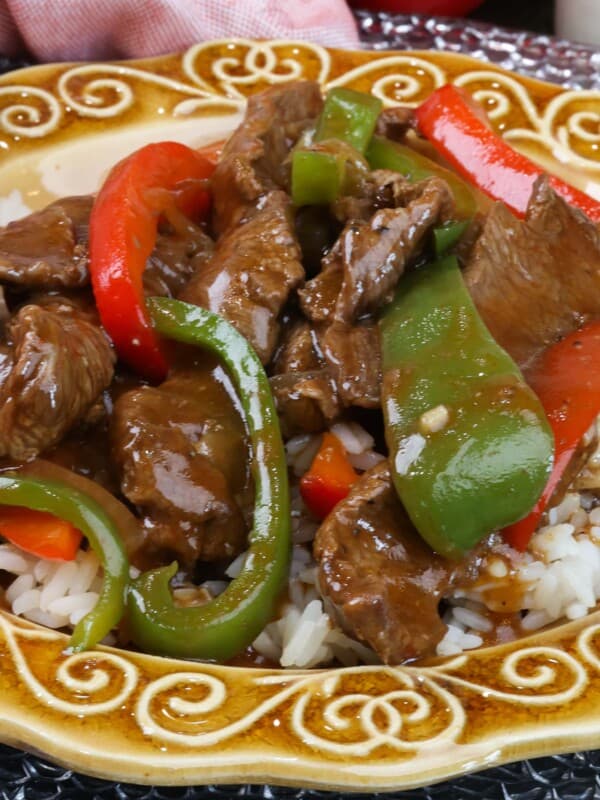


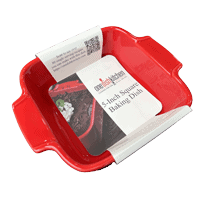









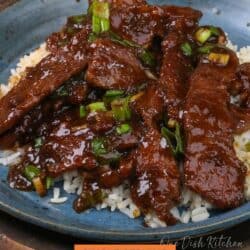
Delicious! Made this tonight, doubled the recipe, and hubby loved it. Added 1/4 tsp chili flakes
Another delicious, easy recipe! Thank you!
Joanne, once again, another delicious recipe will be making this again!
So satisfying! I made as directed and was so yummy. Next time I’ll try adding asparagus, or green pepper, or broccoli or….
Made this for my dinner this evening. It was very tasty.
Thank you. I’m so happy you enjoyed it.
Hi Joanie! First off, thank you for all you do to support us one-two person households who were used to cooking larger meals for more. It’s difficult to adjust to making smaller meals, so I’m appreciative of all you do. I’m positive others’ will agree.
I have a bottle of hoisin sauce in the fridge. Do you think I could sub maybe 1/2 cup in place of the soy sauce/water? I love hoisin sauce and use it in place of catsup and bbq sauce depending on the recipe. Thank you once again.
Thank you, Kaitlyn. I think hoisin sauce should work just fine.
Made it tonight for dinner. Delicious! Added 2 very thinly sliced zucchini. Will definitely make again.
I’m so happy you enjoyed it!
Good recipe.
Thank you!
Is step 6 supposed to be : add the steak back to the pan and mix with the sauce?
Yes, add the steak back to the pan and stir frequently for 2-3 minutes, or until the sauce has thickened.
Good recipe. Didn’t have low sodium soy sauce so used regular. Might try again with low sodium sauce to compare. Definitely worth making again.